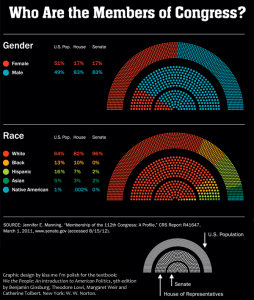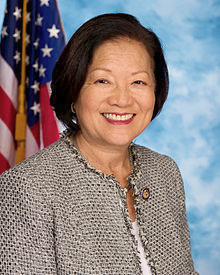Women and minorities have made major gains in the ranks of elected U.S. public office-holders—but at all levels of government the progress has been incomplete and uneven. Consider, for example, America’s fifty state legislatures. Forty years ago, one would have been hard-pressed to find anyone other than a white man serving in any of these legislatures, yet women and various minorities now claim about one-third of the seats. But there are big variations across the states.
By now, women are about 24% of all state legislators, yet their contingents range from ten percent in South Carolina to forty percent in Colorado. African American legislators average 8.1% overall, but the largest contingents (ranging from 20% to 23%) appear in Louisiana, Mississippi, Georgia, and Alabama. Latinos are only 2.9% of all state legislators, and they are concentrated in New Mexico, Texas, California, New York, Nevada, and Arizona.
Apart from population ratios, why do state legislatures vary in diversity—and what difference does it make? Political scientists have made progress in answering these important questions.
Opportunities for Women
After it became socially acceptable for women to run for office, some observers believed they would make steady progress as male incumbents retired, lost bids for re-election, or moved on to higher posts. But it turns out that states with higher turnover, including states with term limits, have not seen greater gains for women legislators. Other barriers and challenges remain.- Women make less office-holding progress in states with traditional cultures and strong, male-dominated party organizations.
- Female legislators have a stronger presence in states with more liberal electorates and more women in non-traditional social positions. Women are more likely to run for office in such settings and party leaders, voters, and interest groups are more willing to support them.
- Women have a greater presence in “citizen” legislatures that meet infrequently and pay low stipends to their part-time, nonprofessional officeholders. States with multi-member legislative districts also tend to elect more women. Perhaps women find entry easier when the offices are less powerful and there are multiple winners.
Overcoming Racial and Ethnic Exclusion

The Voting Rights Act of 1965—and the subsequent use of its provisions to monitor the removal of electoral barriers—has propelled state legislatures toward more closely reflecting the racial and ethnic diversity of state populations. With their rights legally protected, minority electorates can and almost always do elect minority representatives—especially when legislative districts are deliberately designed to encompass majorities of minority voters.
The current situation could be an artificial ceiling for minority legislators, however. To this day, majority-white districts almost always elect white candidates. In the mid-1990s, the Supreme Court began to place limits on the deliberate use of race and ethnicity in drawing district boundaries. Until tools are found to mitigate racial fears and racially polarized voting, dispersing minority voters could cause them to have less leverage in electing minority legislators.
Why Female and Minority Legislators Matter
Proponents of getting more women and minorities into public office presume that they “make a difference.” Scholarly studies have tested various hypotheses and pinpointed key ways in which the presence of female and minority officeholders really does matter.
Most basically, when female and minority citizens see women or co-ethnics in office, they become more politically engaged and empowered. A significant female presence in the legislature increases the chance that women will tell survey researchers they feel they have political influence. Similarly, fellow minorities in office boost African American and Latino voter turnout—and among Latinos at least, alleviate feelings of political alienation. In all these ways, legislative diversity serves to enhance democratic representation and encourage more inclusive civic engagement.

Inside legislatures, female and minority representatives sponsor distinctive kinds of bills:
- Women are more likely than men to introduce legislation about women’s rights and reproductive health choices, and also bills dealing with children, health care, and welfare.
- African American state legislators are more likely (even compared to other Democrats or other representatives with similar constituencies) to introduce measures to combat racial discrimination and boost the socioeconomic and political status of African Africans, as well as measures generally aimed at improving education, health care, and social welfare.
- Latino legislators are most active on issues related to immigration, language learning, and opportunities for migrant laborers.
What about the final votes? The effect of diversity is more ambiguous when it comes to legislative outcomes. One comprehensive study finds that higher percentages of women in state legislatures are associated with the adoption of only eight out of 34 “women-friendly” types of policies. Child support and abortion rights get a boost, according to other studies, but not action to further women’s health or protect women from domestic violence.
Yet numerous studies demonstrate that racial and ethnic diversity in state legislatures can result in very significant policy changes on behalf of minority interests. In particular, when powerful leadership positions go to minority legislators—especially to women of color—the prospects improve for legislation to expand access to social-welfare programs and increase benefit levels. Clearly, the growing clout of women and minority legislators can make a difference.

 Research to Improve Policy: The Scholars Strategy Network seeks to improve public policy and strengthen democracy by organizing scholars working in America's colleges and universities. SSN's founding director is Theda Skocpol, Victor S. Thomas Professor of Government and Sociology at Harvard University.
Research to Improve Policy: The Scholars Strategy Network seeks to improve public policy and strengthen democracy by organizing scholars working in America's colleges and universities. SSN's founding director is Theda Skocpol, Victor S. Thomas Professor of Government and Sociology at Harvard University.
Comments 2
Samantha Cinnick — November 16, 2012
Something that seems intriguing about this article is the discussion of opportunities for women to hold positions of political office and how difficult it can be to attain those positions. One difficulty mentioned was that women are less likely to make progress in political spheres in states that value ‘traditional cultures’ and ‘male-dominated party organizations.’ This gender inequality in politics might be due to reduced cultural and social capital prospects available to women in these areas. For example, if these states still hold traditional culture in high esteem, such as dichotomous gender roles and sexualities as well as 1950s idealized family formations, then many women may not pursue higher forms of education, a very important aspect of cultural capital associated with achieving upward social mobility and higher status in society. Compared to men who have had greater opportunities to engage in activities, like college educations that lead to increased cultural capital, women are still following in the footsteps of men whose cultural capital may far exceed their own. In addition, fewer chances to increase cultural capital may in turn affect women’s social capital. Men who have accumulated cultural capital may have also accumulated friends and social networks that have similar statuses in society therefore leading to higher positions in branches of government. Compared to women whose social networks may include other women in traditional positions such as mother or wife, men are at an advantage when looking for advancement in their field, especially when their social networks may include other politicians.
List of References | WS412 WGS Senior Seminar — March 19, 2013
[...] http://thesocietypages.org/ssn/2012/11/12/minority-representation/ [...]